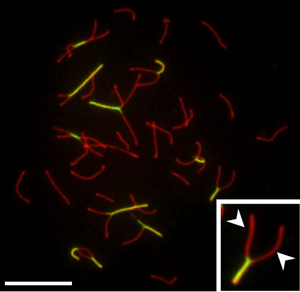Discovery of the function of an ovule and spermatozoon formation protein

11/04/2011
During gametogenesis, precursor cells which develop into gametes (ovules and spermatozoa) undergo a cell division process named meiosis, in which chromosomes pair up in twos and remain united by protein structures known as synaptonemal complex, as well as by crossover points - DNA regions exchanged by both chromosomes. These two actions are essential for gametes to end up with the correct number of chromosomes and prevent the formation of zygotes with additional chromosomes.
In this study researchers determined that the protein HORMAD1, a germ-line specific protein which is also present in humans, is involved in the DNA repair process which leads to chromosome pairing, as well as to the formation of crossover points and the correct formation of synaptonemal complex.
Results also reveal that HORMAD1 takes part in another essential process for the progression of meiosis as is the recruitment of the ATR protein to unpaired chromosomal regions. When this mechanism fails protein synthesis of specific genes is induced and this ends up being toxic for precursor cells.
According to Dr Roig, the discovery will help to learn more about the mechanisms regulating the formation of sperms and eggs and in the prediction of specific genes which, in the case of mutations, could create fertility problems in humans.
The study included participation of researchers from Howard Hughes Medical Institute and Memorial Sloan-Kettering Cancer Center, USA; Centre National de la Recherche Scientifique, France; and Medical Research Council Human Genetics Unit, UK.
The HORMAD1 protein was discovered in 2009 by the same researchers who now have described its function. Similar proteins in other species are known to exist, as well as the role they play in the formation processes of crossover points and synaptonemal complex. Until now however these roles had not been demonstrated in proteins in mice.
Reference article: Daniel K., Lange J., Hached K., Fu J, Anastassiadis K., Roig I., Cooke H.J., Stewart A.F., Wassmann K., Jasin M., Keeney S., Tóth A. "Meiotic homologue alignment and its quality surveillance are controlled by mouse HORMAD1". Nature Cell Biology. DOI 10.1038/ncb2213.